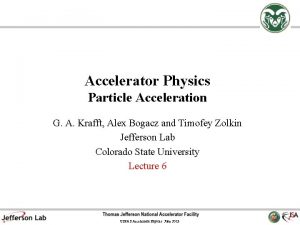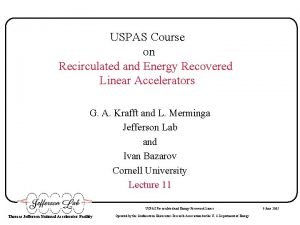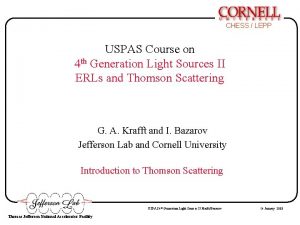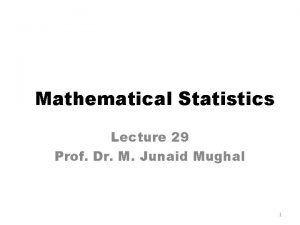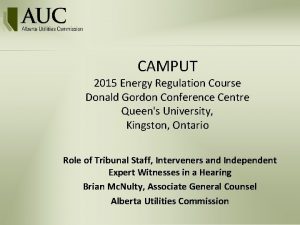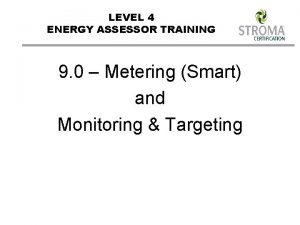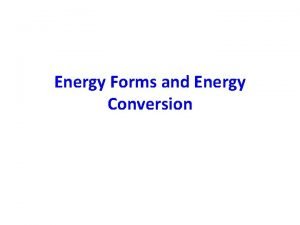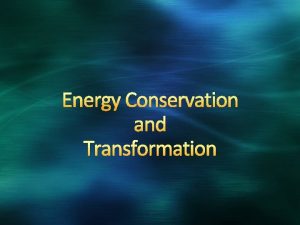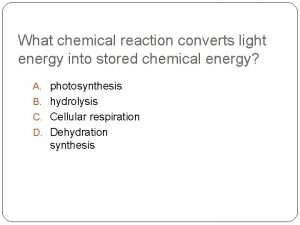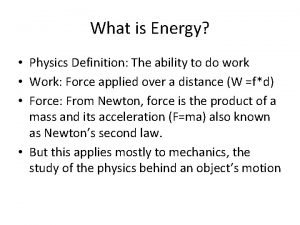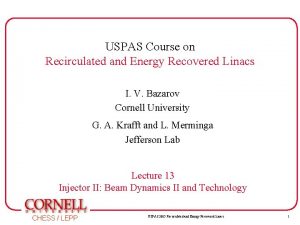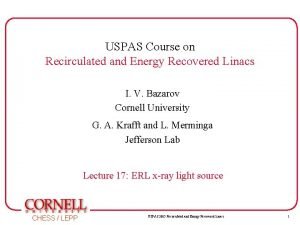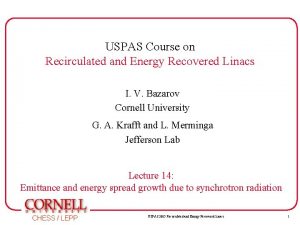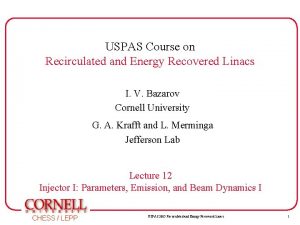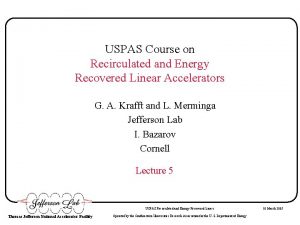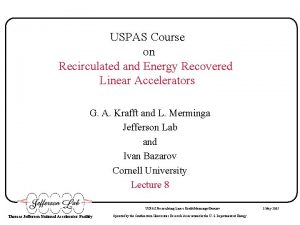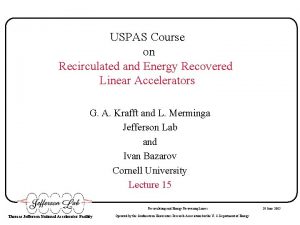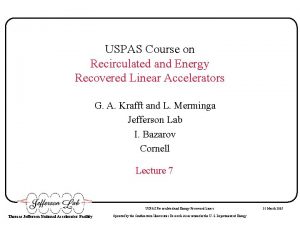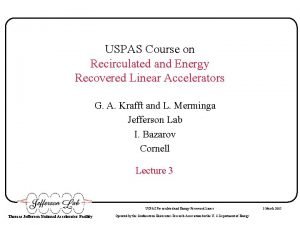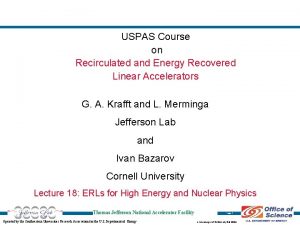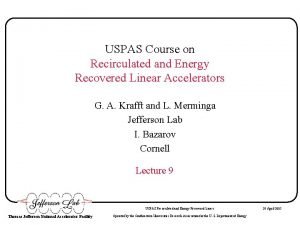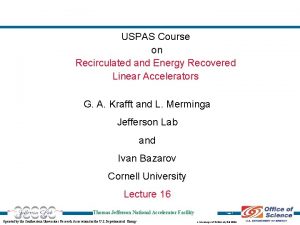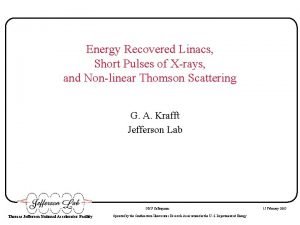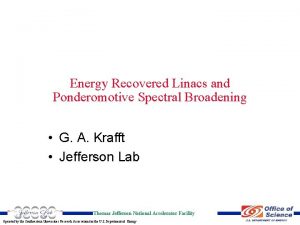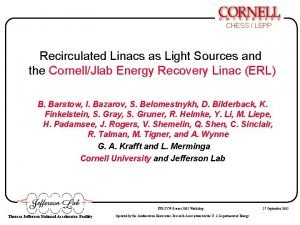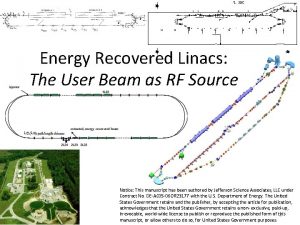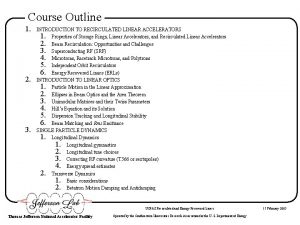USPAS Course on Recirculated and Energy Recovered Linacs














































- Slides: 46

USPAS Course on Recirculated and Energy Recovered Linacs G. A. Krafft and A. Bogacz Jefferson Lab Timofey Zolkin Lecture 12: ERL x-ray light source USPAS Accelerator Physics June 2013

High Field Spectral Distribution In the beam frame (2. 16) where USPAS Accelerator Physics June 2013

In the lab frame USPAS Accelerator Physics June 2013

fn. N is highly peaked, with peak value n. N, around angular frequency USPAS Accelerator Physics June 2013

Energy Distribution in Lab Frame (2. 17) The arguments of the Bessel Functions are now USPAS Accelerator Physics June 2013

In the Forward Direction In the forward direction even harmonics vanish (n+2 k’ term vanishes when “x” Bessel function non-zero at zero argument, and all other terms in sum vanish with a power higher than 2 as the argument goes to zero), and for odd harmonics only n+2 k’=1, -1 contribute to the sum USPAS Accelerator Physics June 2013

Number Spectral Angular Density Converting the energy density into an number density by dividing by the photon energy (don’t forget both signs of frequency!) Peak value in the forward direction USPAS Accelerator Physics June 2013

Radiation Pattern: Qualitatively Non-zero Angular Density Emission at a Given Frequency Central Cone Doppler Downshifted Harmonic Radiation Central cone: high angular density region around forward direction USPAS Accelerator Physics June 2013

Dimension Estimates Harmonic bands at Central cone size estimated by requiring Gaussian distribution with correct peak value integrate over solid angle to the same number of total photons as integrating f Much narrower than typical opening angle for bend USPAS Accelerator Physics June 2013

Number Spectral Density (Flux) The flux in the central cone is obtained by estimating solid angle integral by the peak angular density multiplied by the Gaussian integral USPAS Accelerator Physics June 2013

Power Angular Density Don’t forget both signs of frequency! USPAS Accelerator Physics June 2013

For K less than or of order one Compare with (2. 10) USPAS Accelerator Physics June 2013

? USPAS Accelerator Physics June 2013

ERL light source idea Third generation light sources are storage ring based facilities optimized for production of high brilliance x-rays through spontaneous synchrotron radiation. The technology is mature, and while some improvement in the future is likely, one ought to ask whether an alternative approach exists. Two orthogonal ideas (both linac based) are XFEL and ERL. XFEL will not be spontaneous synchrotron radiation source, but will deliver GW peak powers of transversely coherent radiation at very low duty factor. The source parameters are very interesting and at the same time very different from any existing light source. ERL aspires to do better what storage rings are very good at: to provide radiation in quasi-continuous fashion with superior brilliance, monochromaticity and shorter pulses. USPAS Accelerator Physics June 2013

Coherent or incoherent? Radiation field from a single kth electron in a bunch: Radiation field from the whole bunching factor (b. f. ) Radiation Intensity: 1) “long bunch”: single electron => 2) “short bunch” or m-bunching: => incoherent (conventional) SR coherent (FELs) SR ERL hard x-ray source is envisioned to use conventional SR USPAS Accelerator Physics June 2013

Demand for X-rays Ion channel protein ~85% structures by x-ray crystallography CHESS 2003 Nobel Prize in Chemistry: Roderick Mac. Kinnon (Rockefeller Univ. ) st 1 K+ channel structure by x-ray crystallography based on CHESS data (1998) USPAS Accelerator Physics June 2013

X-ray characteristics needed • for properly tuned undulator: X-ray phase space is a replica from electron bunch + convolution with the diffraction limit • ideally, one wants the phase space to be diffraction limited (i. e. full transverse coherence), e. g. , rms = /4 , or 0. 1 Å for 8 ke. V X-rays (Cu K ), or 0. 1 m normalized at 5 Ge. V Flux ph/s/0. 1%bw Brightness ph/s/mrad 2/0. 1%bw Brilliance ph/s/mm 2/mrad 2/0. 1%bw USPAS Accelerator Physics June 2013

Introduction Let’s review why ERL is a good idea for a light source Critical electron beam parameters for X-ray production: 6 D Phase Space Area: – Horizontal Emittance {x, x’} – Vertical Emittance {y, y’} – Energy Spread & Bunch length {ΔE, t} Number of Electrons / Bunch, Bunch Rep Rate: Ipeak, Iaverage USPAS Accelerator Physics June 2013

Introduction (contd. ): adiabatic damping p 1 px θ 1, x p 1, z linac electron bunch ε 1 geometric {x, θx} εn ε= βγ px θ 2, x p 1, z ε 2 = ε 1 p 2, z normalized px {x, 2 } mc εn is invariant since {x; px = mc 2βγ·θx} form canonically conjugate variables USPAS Accelerator Physics June 2013

Introduction (contd. ): storage rings (I) Equilibrium Quantum Excitation vs. Radiative Damping Eph Emittance (hor. ), Energy Spread, Bunch Length USPAS Accelerator Physics June 2013

Introduction (contd. ): storage rings (II) Touschek Effect Beam Lifetime vs. Space Charge Density USPAS Accelerator Physics June 2013

Introduction (contd. ): why ERL? ESRF 6 Ge. V @ 200 m. A ERL 5 Ge. V @ 10 -100 m. A εx = 4 nm mrad εy = 0. 02 nm mrad B ~ 1020 ph/s/mm 2/mrad 2/0. 1%BW LID = 5 m εx = εy 0. 01 nm mrad B ~ 1023 ph/s/mm 2/mrad 2/0. 1%BW LID = 25 m ERL (no compression) ERL (w/ compression) ESRF t USPAS Accelerator Physics June 2013

Comparing present and future sources electron beam brilliance electron beam monochromaticity A/(nm-rad)2 max Nund A/(nm-rad)2 compares brilliance from two short identical (K, Nund) undulators A/(nm-rad)2 max Nund compares maximum achievable brilliance USPAS Accelerator Physics June 2013

1 Angstrom brilliance comparison ERL better by ERL emittance is taken to be (PRSTAB 8 (2005) 034202) n[mm-mrad] (0. 73+0. 15/ z[mm]2. 3) q[n. C] plus a factor of 2 emittance growth for horizontal USPAS Accelerator Physics June 2013

Cornell vision of ERL light source To continue the long-standing tradition of pioneering research in synchrotron radiation, Cornell University is carefully looking into constructing a first ERL hard x-ray light source. But first… SASE ? USPAS Accelerator Physics June 2013

Need for the ERL prototype Issues include: § CW injector: produce iavg 100 m. A, qbunch ~ 80 p. C @ 1300 MHz, n < 1 mm mr, low halo with very good photo-cathode longevity. § Maintain high Q and Eacc in high current beam conditions. § Extract HOM’s with very high efficiency (PHOM ~ 10 x previous ). § Control BBU by improved HOM damping, parameterize ithr. § How to operate with hi QL (control microphonics & Lorentz detuning). § Produce + meas. t ~ 100 fs with qbunch ~ 0. 3– 0. 4 n. C (iavg < 100 m. A), understand / control CSR, understand limits on simultaneous brilliance and short pulses. § Check, improve beam codes. Investigate multipass schemes. Our conclusion: An ERL Prototype is needed to resolve outstanding technology and accelerator physics issues before a large ERL is built USPAS Accelerator Physics June 2013

Cornell ERL Prototype Energy 100 Me. V Max Avg. Current 100 m. A Charge / bunch 1 – 400 p. C Emittance (norm. ) 2 mm mr@77 p. C Injection Energy 5 – 15 Me. V Eacc @ Q 0 20 Me. V/m @ 1010 Bunch Length 2 – 0. 1 ps USPAS Accelerator Physics June 2013

Cornell ERL Phase I: Injector Parameters: Beam Energy Range Max Average Beam Current Max Bunch Rep. Rate @ 77 p. C Transverse Emittance, rms (norm. ) Bunch Length, rms Energy Spread, rms 5 – 15 a Me. V 100 m. A 1. 3 GHz < 1 b mm 2. 1 ps 0. 2 % at reduced average current b corresponds to 77 p. C/bunch a USPAS Accelerator Physics June 2013

To learn more about Cornell ERL Two web-sites are available 1) Information about Cornell ERL, X-ray science applications, other related projects worldwide http: //erl. chess. cornell. edu/ 2) ERL technical memorandum series http: //www. lepp. cornell. edu/public/ERL/ USPAS Accelerator Physics June 2013

Bend Undulator Wiggler e– e– white source partially coherent source USPAS Accelerator Physics June 2013 Flux [ph/s/0. 1%bw] Brightness [ph/s/mm 2/mr 2/0. 1%bw] e– powerful white source

Undulator Radiation from Single Electron y S N S x z N Approaches: S Halbach permanent magnet undulator: N for Sm. Co 5, here p 1. Solve equation of motion (trivial), grab Jackson and calculate retarded potentials (not so trivial – usually done in the far field approximation). Fourier Transform the field seen by the observer to get the spectrum. More intuitively in the electron rest frame: 2. Doppler shift to the lab frame (nearly) simple harmonic oscillator radiation. 3. Doppler shift Thomson back-scattered undulator field “photons”. Or simply 4. Write interference condition of wavefront emitted by the electron. USPAS Accelerator Physics June 2013

off-axis on axis Intuitive understanding of undulator radiation back to lab frame after pin-hole aperture e– (for fixed θ only!) in e– frame USPAS Accelerator Physics June 2013

Higher Harmonics / Wiggler even odd log wiggler motion in e– frame K ≤ 1 undulator K > 1 wiggler K nc 1 1 2 4 4 27 8 198 1548 critical harmonic number for 16 wiggler (in analogy to c of bending magnet) continuum 2 N spikes bend log wiggler and bend spectra after pin-hole aperture USPAS Accelerator Physics June 2013

Total Radiation Power or e. g. about 1 photon from each electron in a 100 -pole undulator, or 1 k. W c. w. power from 1 m insertion device for beam current of 100 m. A @ 5 Ge. V, K = 1. 5, p = 2 cm Note: the radiated power is independent from electron beam energy if one can keep B 0 p const, while p ~ 2 to provide the same radiation wavelength. (e. g. low energy synchrotron and Thomson scattering light sources) However, most of this power is discarded (bw ~ 1). Only a small fraction is used. Radiation Needed wavelength 0. 1 – 2 Å (if a hard x-ray source) temporal coherence bw 10 -2 – 10 -4 spatial coherence small source size & divergence USPAS Accelerator Physics June 2013

Undulator Central Cone Select with a pin-hole aperture the cone: to get bw: Flux in the central cone from nth harmonic in bw : n=1 3 Note: the number of photons in bw ~ 1/N is about 2 % max of the number of e– for any-length undulator. 5 9 Undulator “efficiency”: Function USPAS Accelerator Physics June 2013 7

A Word on Coherence of Undulator Radiation contained in the central cone is transversely coherent (no beam emittance!) apparent source disk Young’s double-slit interference condition: r c d in Fraunhofer limit: L R same as central cone Spatial coherence (rms): Temporal coherence: , Photon degeneracy: x-ray source Rings 1 ERLs 1 XFEL 1 Next, we will study the effect of finite beam 6 D emittance on undulator radiation. USPAS Accelerator Physics June 2013

Brightness Definition: Geometric Optics Brightness is a measure of spatial (transverse) coherence of radiation. Spectral brightness (per 0. 1 % BW) is usually quoted as a figure of merit, which also reflects temporal coherence of the beam. The word “spectral” is often omitted. Peak spectral brightness is proportional to photon degeneracy. For the most parts we will follow K-J Kim’s arguments regarding brightness definitions. A ray coordinate in 4 D phase space is defined as Brightness is invariant in lossless linear optics as well as flux: while flux densities are not: USPAS Accelerator Physics June 2013

Brightness Definition: Wave Optics here electric field in frequency domain is given in either coordinate or angular representation. Far-field (angular) pattern is equivalent to the Fourier transform of the near-field (coordinate) pattern: A word of caution: brightness as defined in wave optics may have negative values when diffraction becomes important. One way to deal with that is to evaluate brightness when diffraction is not important (e. g. z = 0) and use optics transform thereafter. USPAS Accelerator Physics June 2013

Diffraction Limit Gaussian laser beam equation: With corresponding brightness: USPAS Accelerator Physics June 2013

Effect of Electron Distribution Previous result from undulator treatment: The field in terms of reference electron trajectory for ith-electron is given by: phase of ith-electron For brightness we need to evaluate the following ensemble average for all electrons: 2 nd term is the “FEL” term. Typically , so only the 1 st term is important. USPAS Accelerator Physics June 2013

Effect of Electron Distribution (contd. ) electron distribution Brightness due to single electron has been already introduced. Total brightness becomes a convolution of single electron brightness with electron distribution function. Brightness on axis due to single electron: USPAS Accelerator Physics June 2013 flux in the central cone

Finite Beam Emittance Effect Oftentimes brightness from a single electron is approximated by Gaussian: Including the electron beam effects, amplitude and sigma’s of brightness become: USPAS Accelerator Physics June 2013

Matching Electron Beam Matched -function is given by (beam waist at the center of undulator): j x Brightness on axis becomes: transversely coherent fraction of the central cone flux Matched -function has a broad minimum (for )

Energy Spread of the Beam Energy spread of the beam can degrade brightness of undulators with many periods. If the number of undulator periods is much greater than will not grow with the number of periods. Maximal spectral brightness on axis becomes USPAS Accelerator Physics June 2013 , brightness

Photon Degeneracy Number of photons in a single quantum mode: Peak brightness is a measure of photon degeneracy E. g. maximum photon degeneracy that is available from undulator (non-FEL) diffraction-limited emittance dominated USPAS Accelerator Physics June 2013

More reading on synchrotron radiation 1. K. J. Kim, Characteristics of Synchrotron Radiation, AIP Conference Proceedings 189 (1989) pp. 565 -632 2. R. P. Walker, Insertion Devices: Undulators and Wigglers, CERN Accelerator School 98 -04 (1998) pp. 129 -190, and references therein. Available on the Internet at http: //preprints. cern. ch/cernrep/1998/9804/98 -04. html 3. B. Lengeler, Coherence in X-ray physics, Naturwissenschaften 88 (2001) pp. 249 -260, and references therein. 4. D. Attwood, Soft X-rays and Extreme UV Radiation: Principles and Applications, Cambridge University Press, 1999. Chapters 5 (Synchrotron Radiation) and 8 (Coherence at Short Wavelength) and references therein. USPAS Accelerator Physics June 2013
 Uspas sport
Uspas sport Uspas
Uspas Uspas
Uspas Energy energy transfer and general energy analysis
Energy energy transfer and general energy analysis Energy energy transfer and general energy analysis
Energy energy transfer and general energy analysis Course title and course number
Course title and course number Which is not the “effect of accident on worker”
Which is not the “effect of accident on worker” Recovered memory 17
Recovered memory 17 When the royalty are less the minimum rent
When the royalty are less the minimum rent Dr junaid mughal
Dr junaid mughal Soldier course vs sailor course
Soldier course vs sailor course Course interne course externe
Course interne course externe Camput energy regulation course
Camput energy regulation course Domestic energy assessor course near me
Domestic energy assessor course near me Describing energy section 2 answers
Describing energy section 2 answers Primary energy and secondary energy
Primary energy and secondary energy What is commercial energy source
What is commercial energy source Helmholtz free energy
Helmholtz free energy Renewable energy and energy efficiency partnership
Renewable energy and energy efficiency partnership Where is the highest potential energy
Where is the highest potential energy Kinetic energy of a spring
Kinetic energy of a spring Potential energy
Potential energy Potential energy units
Potential energy units Energy forms and energy conversions
Energy forms and energy conversions Define kinetic energy
Define kinetic energy Gibbs free energy non standard conditions
Gibbs free energy non standard conditions Gibbs free energy
Gibbs free energy A heavy container has been raised up above ground level
A heavy container has been raised up above ground level Thermal energy vs heat energy
Thermal energy vs heat energy A hairdryer converts ____ energy into ____ energy.
A hairdryer converts ____ energy into ____ energy. Energy formula physics
Energy formula physics How to convert mechanical energy to electrical energy
How to convert mechanical energy to electrical energy Section 3 using thermal energy
Section 3 using thermal energy Calculate delta g
Calculate delta g What ecological role best describes grizzly bears?
What ecological role best describes grizzly bears? Usable chemical energy in food begins as __________ energy.
Usable chemical energy in food begins as __________ energy. Chapter 7 energy conservation of energy
Chapter 7 energy conservation of energy Wind energy is an indirect form of solar energy
Wind energy is an indirect form of solar energy ________ converts light energy into chemical energy. *
________ converts light energy into chemical energy. * Gravity
Gravity Definition of elastic potential energy
Definition of elastic potential energy Electric field energy
Electric field energy Definition of energy in physics
Definition of energy in physics Forms of energy
Forms of energy Gravitational potential energy vs kinetic energy
Gravitational potential energy vs kinetic energy How to calculate useful energy output
How to calculate useful energy output Kinetic energy to thermal energy
Kinetic energy to thermal energy
